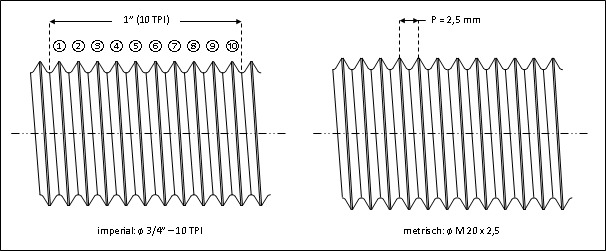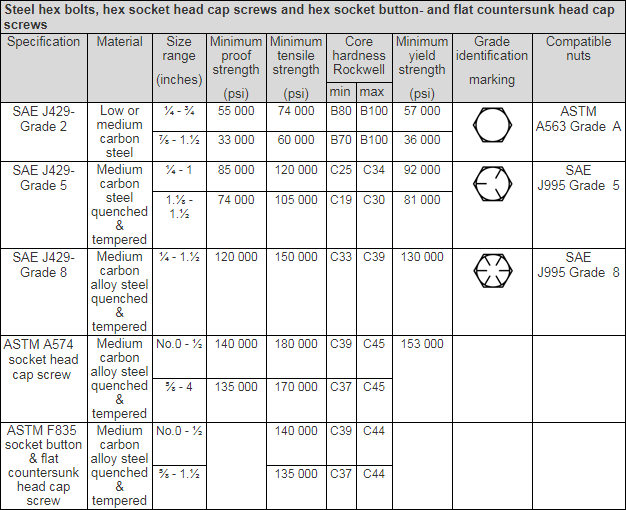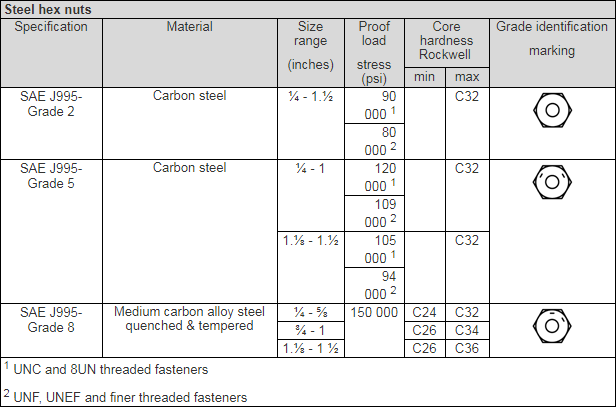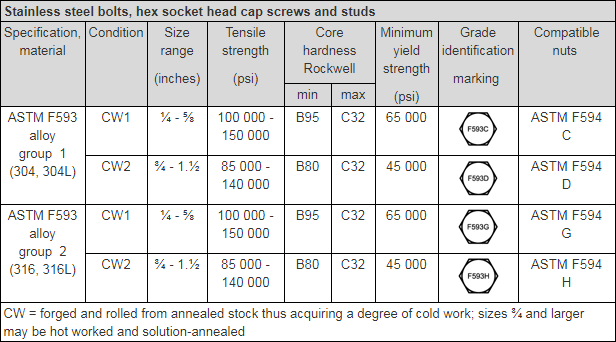IMPERIAL FASTENERS
MEASURING SYSTEMS
There are two main systems for measuring weights and distances: the metric system and the imperial system. The imperial system is based on the British Weight and Measures Act of 1824, and although its popularity has gradually diminished, it is still common practice in several English-speaking countries and former British colonies. Dimensions of products according to the imperial system are expressed in thou (UK) or mil (USA), inches, feet, yards, miles etc. Although the official designation for the USA measurement system is the U.S. customary system, which overall comprises some differences from the official imperial system, the systems for fasteners are equal or at least highly compatible. The most commonly used dimensional units for fasteners are inches and feet. Units to express stress and pressure in the imperial system are pound force per square inch (lbf/in2 or psi); 1,000 psi equals 1 ksi, kilopound force per square inch. One ksi is approximately equal to 6.9 MPa (= N/mm2).
The base unit “inch” equals exactly 25.4 mm. There are 12 inches in 1 foot, making 1 foot equivalent to 304.8 mm. One yard equals 3 feet, or 36 inches, and therefore measures 914.4 mm. Inches in dimensional references are abbreviated simply as a double quotation mark (”). Throughout the UK, dimensions in inches are most often presented as fractions (e.g., 3/4", 1.17/64”), whereas in the USA, the decimal notation is often used for dimensions that are not nominal (e.g. 1.2656”, but also 3/4”).
Another significant difference between the imperial and metric systems is that the pitch of screw threads is expressed as the number of threads per inch (TPI), as opposed to the metric system in which the pitch (P) is defined as the distance between two thread crests. Conversion is easy, as demonstrated in the below illustration. A thread with 10 TPI has a pitch P of 25.4/10 = 2.54 mm.

COMMON INCH SCREW THREAD TYPES
UNIFIED INCH SCREW THREADS – NATIONAL COARSE (UNC) AND CONSTANT PITCH (8UN)
The most common thread type in the US is the Unified National coarse thread, abbreviated UNC (sometimes “NC” is used). This is the standard coarse thread in the USA. Unified inch screw threads are designed with a 60° thread angle and several diameter and pitch combinations. This thread system was developed by William Sellers in 1864, and within a few years, the system had been adopted as the American standard. Detailed information about this thread type can be found in the standards ASME B1.1 and ISO 5864.
Examples of UNC thread designations are 3/8” UNC, or better 3/8”-16UNC, in which 16 is the number of threads per inch (TPI) and the quote symbol ” means inch. An example of a complete designation for the nominal diameter of an externally threaded fastener is 3/8”-16UNC-2A, which also incorporates the thread class 2A, or the ‘standard’ class with an allowance – a fundamental deviation from the nominal diameter – and a tolerance field. Internally threaded fasteners are designated as 3/8”-16UNC-2B, with 2B being the ‘standard’ class without allowance and with only a tolerance field.
The smallest standardized UNC threads, from 0.0730” in diameter to 0.2160”, are designated as numbered threads: No.1-64UNC to No.12-24UNC. Larger diameters are designated as fractions, starting from 1/4”-20UNC up to 6” in diameter.
The 8UN thread is a constant pitch variant of the UNC thread. The 8 in 8UN means that above a certain nominal diameter (limits are given in the abovementioned standards), the pitch of an 8UN thread is always 8 TPI for every thread diameter. In the case of 8UN, all diameters over 1” have this constant 8 TPI pitch. An 8UN thread is commonly used for petrochemical fasteners like stud bolts. Their complete designation is similar to UNC designations; e.g., 1.1/2”-8UN-2A/2B or 3.1/4”-8UN-2A/2B. Other, (far) less common constant pitch series are 4UN, 6UN, 12UN up to 32UN.
All thread diameters with diameter and pitch combinations that are not included in the standard series from the abovementioned screw thread standards, but with allowances and tolerances calculated according to the formulae in these standards, are designated UNS, where “S” refers to a special thread.
UNIFIED INCH SCREW THREADS – NATIONAL FINE (UNF) AND EXTRA FINE (UNEF)
The Unified National fine thread, abbreviated as UNF (sometimes “NF”), is the fine-pitched version of unified inch screw threads commonly used in the USA, and UNEF is the designation for an extra-fine pitch thread with even more TPI than UNF threads. Unified inch screw threads are designed with a 60° thread angle and several diameter and pitch combinations. This thread system was developed by William Sellers in 1864, and within a few years the system was adopted as an American Standard. Detailed information about this thread type can be found in the standards ASME B1.1 and ISO 5864.
Examples of UNF thread designations are 3/8” UNF, or better 3/8”-24UNF, in which 24 is the number of threads per inch (TPI) and the symbol ” designates the inch unit. An example of a complete designation for the nominal diameter of an externally threaded fastener is 3/8”-24UNF-2A, which also incorporates the thread class, 2A, which is the ‘standard’ class with an allowance – a fundamental deviation from the nominal diameter – and a tolerance field. Internally threaded fasteners are designated as 3/8”-24UNF-2B, and 2B is the ‘standard’ class without allowance, only with a tolerance field; UNEF threads are similarly designated 3/8”-32UNEF-2A/2B.
The smallest standardized UNF threads are 0.0600” in diameter, and they increase up to 0.2160” in diameter. These sizes are designated as numbered threads from No.0-80UNF to No.12-28UNF. Larger diameters are designated as fractions, starting from 1/4”-28UNF up to 1.1/2”-12UNF in diameter. The smallest UNEF size is No.12-32UNEF, and the series’ greatest diameter is 1.11/16”-18UNEF.
There is some confusion around the nominal diameter 1” as far as UNF thread is concerned. In the standard ASME B1.1, the 1” UNF thread has 12 TPI. However, for many years, dating as far back as 1935, non-standard 1”-14UNS fasteners with 14 TPI have been widely used instead of the standard-sized 1”-12UNF fasteners. Table 2 of ASME B1.1 includes a footnote relating to 1”-14 TPI thread (designated as 1”-14UNS): “Formerly NF. Not a recommended standard size. Tolerances and allowances are based on one diameter length of engagement.”
After several decades, 1"-14UNS fasteners are commonly referred to as standard fine thread or UNF. Though technically incorrect, 1"-14UNF is universally accepted as a standard for fine-threaded 1” fasteners, and 1”-14UNF has become established as a “common use” term. This being the case, when fasteners with a 1” UNF thread are discussed, it is always wise to check the required TPI.
BRITISH STANDARD WHITWORTH (BSW OR WW) THREADS
An imperial thread type originating from the UK is British Standard Whitworth thread, which is abbreviated to BSW or simply WW. The BSW was the most common coarse screw thread measure in the UK, but its popularity quickly diminished due to the global tendency to prefer metric threads. British Standard Whitworth threads are designed with a 55° thread angle. This thread type owes its name to the Englishman Sir Joseph Whitworth, who, in 1841, proposed the standardization of screw threads. His proposals became standard practice in Britain in the 1860s and are credited as the world's first national screw thread standard. Detailed information about this thread type can be found in the standard BS 84.
Examples of the thread designations: 3/8” WW, 3/8” BSW, or better 3/8”-16BSW, in which 16 is the number of threads per inch (TPI) and the symbol ” means inch. If needed, the thread class can be mentioned in brackets after the designation; BS 84 provides the classes close and free (for externally threaded fasteners only), normal (for internally threaded fasteners only) and medium for both bolts and nuts. If there are no specifications, a normal or medium class will be supplied.
BSW threads are standardized in diameters from 1/8”-40BSW through 6”-2.5BSW. Interchangeability with UNC threads is possible because some BSW diameter-pitch combinations are equal, but this is not recommended due to the different thread angles and other minor differences in thread configuration.
BRITISH STANDARD FINE (BSF) THREADS
The British Standard Fine thread, abbreviated to BSF, is the fine-pitched variant of the BSW (British Standard Whitworth) thread form. This unite once was the most common coarse screw thread in the UK, but its popularity quickly diminished due to the global preference for metric threads. British Standard Fine threads, just as BSW threads, are designed with a 55° thread angle. Detailed information about this thread type can be found in the standard BS 84.
Examples of the thread designations: 3/8” BSF, or better 3/8”-20BSF, in which 20 is the number of threads per inch (TPI) and the symbol ” means inch. If needed, the thread class can be mentioned in brackets after the designation; BS 84 provides the following classes: close and free (for externally threaded fasteners only), normal (for internally threaded fasteners only) and medium for both bolts and nuts. If no specification is provided, then normal or medium class will be supplied.
BSF threads are standardized in diameters from 3/16”-32BSF through 4.1/4”-4BSF. There are no BSF diameter and pitch combinations equal to those with UNF or UNEF threads.
PIPE THREADS (BSP)
BSP pipe thread, often referred to as Whitworth pipe thread, is the most commonly used thread type for piping applications in the world. All sorts of products are equipped with this thread type, including pipes, pipe fittings, lubricating nipples and so on. BSP threads are designed with a 55° thread angle. Every aspect of this thread type can be found in detail in the standards for BSP thread, EN ISO 228-1 or EN 10226-1 and EN 10226-2 (the latter two are based on ISO 7-1).
The BSP thread exist in two types: the parallel or cylindrical type (BSPP) and the tapered or conical (BSPT) type. EN ISO 228-1 describes external and internal BSPP threads as unsuitable for creating pressure-tight joints on the threads. If assemblies with BSPP threads must be made pressure tight, it can be achieved by compressing two tightening surfaces outside of the threads and interposing an appropriate seal. EN 10226-1 describes the combination of external BSPT with internal BSPP threads, and EN 10226-2 describes the combination of external and internal BSPT threads; both systems are fit to establish a pressure-tight joint on the thread flanks (jointing threads). It may be advisable to use a sealing agent (e.g., PTFE tape) to optimize the tightness of the joint and prevent spiral leaks.
The designation of the nominal diameter for BSP threads is the pipe size. Parallel external and internal threads, for which the pressure tight joint is not made on the threads (EN ISO 228-1), are designated as G. External threads are additionally designated with the letter A or B to indicate the tolerance class. For thread types that make a pressure-tight joint on the threads (EN 10226), the designations are R for tapered external thread, Rp for parallel internal thread and Rc for tapered internal thread.
Examples are G1.1/2” and G1.1/2”A for parallel external and internal threads, respectively, according to EN ISO 228-1. For tapered external threads, there is R1.1/2”, while Rp1.1/2” is for parallel internal thread and Rc1.1/2” is for tapered internal thread, according to EN 10226.
A standard for a variety of pipe threads (NPT, NPSC, NPTR, NPSM and NPSL), ASME B1.20.1, should also be mentioned, as should ASME B1.20.3, which is a standard for dry-seal pipe threads (NPTF-1, NPTF-2, PTF-SAE SHORT, NPSF and NPSI). The latter threads may establish a pressure-tight sealing without the use of sealing agents; due to the interference between thread crest and root, a circular seal forms. All of these threads are based on a 60° thread angle and have similar functionality as the aforementioned BSPP and BSPT threads. They are designated by the combination of the pipe size and pitch and the thread type abbreviation. These pipe threads are mainly used in the US. Pipe threads to these standards are not interchangeable with BSP threads.
STANDARDS FOR IMPERIAL FASTENERS AND THEIR MATERIALS
A norm or a standard is a document containing agreements, specifications or criteria about a product, service or method. Standards are established within a company, an organization, a consortium of organizations or recognized standardization bodies. Recognized standardization bodies (national and international) work according to a predefined process.
A standard is of great importance in international trade. Standards ensure that products or services are more easily accepted in other countries. When a standard exists, a product requires little or no further description. Most of the features of a product are described in the standard; in case of fasteners, standards often explain dimensions, tolerances, materials and mechanical properties. Standards also simplify the information and dissemination of new technologies.
The primary standardization organizations for imperial fasteners:
AISI – American Iron and Steel Institute
ANSI – American National Standards Institute
ASME – American Society of Mechanical Engineers
ASTM – American Society for Testing and Materials
BS – British Standard
IFI – Industrial Fasteners Institute
SAE – Society of Automotive Engineers

MECHANICAL PROPERTIES FOR IMPERIAL FASTENERS
The requirements for the mechanical properties of imperial fasteners are specified in SAE and ASTM standards. In the below tables, mechanical properties for some common fasteners are summarized.




APPLICATION AREAS FOR IMPERIAL FASTENERS
Products manufactured in areas of the world that use the imperial system of measurement often contain imperial-denoted fasteners. The products may be produced elsewhere, but when they are destined for countries that use the imperial system, they may contain imperial fasteners.
FIELDS IN WHICH IMPERIAL FASTENERS ARE COMMON
- Automotive industry
- Transportation industry (e.g., aerospace, railways, maritime)
- Petrochemical industry
- Machine-building industry
- Construction
- Lifting industry
- Electronics and electrical engineering
- Products for the imperial markets